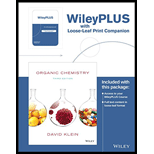
Organic Chemistry, 3e WileyPLUS Registration Card + Loose-leaf Print Companion
3rd Edition
ISBN: 9781119340577
Author: Klein
Publisher: Wiley (WileyPLUS Products)
expand_more
expand_more
format_list_bulleted
Concept explainers
Question
Chapter 25, Problem 91CP
(a)
Interpretation Introduction
Interpretation:
The p-nitrophenol ester activates the carbonyl group toward nucleophilic acyl substitution has to be explained.
(b)
Interpretation Introduction
Interpretation:
The function of the nitro group has to be determined.
(c)
Interpretation Introduction
Interpretation:
Meta-nitrophenyl ester is less activating than a para-nitrophenyl ester; the reason has to be explained.
Expert Solution & Answer
Want to see the full answer?
Check out a sample textbook solution
Students have asked these similar questions
please help with hw
help me solve this hw
help me solve this hw
Chapter 25 Solutions
Organic Chemistry, 3e WileyPLUS Registration Card + Loose-leaf Print Companion
Ch. 25.2 - Prob. 1CCCh. 25.2 - Prob. 2CCCh. 25.2 - Prob. 3CCCh. 25.2 - Prob. 1LTSCh. 25.2 - Prob. 4PTSCh. 25.2 - Prob. 5ATSCh. 25.2 - Prob. 6ATSCh. 25.2 - Prob. 7CCCh. 25.2 - Prob. 8CCCh. 25.2 - Prob. 9CC
Ch. 25.2 - Prob. 10CCCh. 25.3 - Prob. 11CCCh. 25.3 - Prob. 12CCCh. 25.3 - Prob. 13CCCh. 25.3 - Prob. 2LTSCh. 25.3 - Prob. 14PTSCh. 25.3 - Prob. 15ATSCh. 25.3 - Prob. 16ATSCh. 25.3 - Prob. 17CCCh. 25.3 - Prob. 18CCCh. 25.3 - Prob. 19CCCh. 25.3 - Prob. 20CCCh. 25.4 - Prob. 3LTSCh. 25.4 - Prob. 21PTSCh. 25.4 - Prob. 22ATSCh. 25.4 - Prob. 23ATSCh. 25.4 - Prob. 24ATSCh. 25.4 - Prob. 25CCCh. 25.4 - Prob. 26CCCh. 25.4 - Prob. 27CCCh. 25.4 - Prob. 28CCCh. 25.4 - Prob. 29CCCh. 25.5 - Prob. 30CCCh. 25.5 - Prob. 4LTSCh. 25.5 - Prob. 31PTSCh. 25.5 - Prob. 32ATSCh. 25.5 - Prob. 33ATSCh. 25.6 - Prob. 5LTSCh. 25.6 - Prob. 34PTSCh. 25.6 - Prob. 35ATSCh. 25.6 - Prob. 36ATSCh. 25.6 - Prob. 6LTSCh. 25.6 - Prob. 37PTSCh. 25.6 - Prob. 38ATSCh. 25.7 - Prob. 39CCCh. 25 - Prob. 40PPCh. 25 - Prob. 41PPCh. 25 - Prob. 42PPCh. 25 - Prob. 43PPCh. 25 - Prob. 44PPCh. 25 - Prob. 45PPCh. 25 - Prob. 46PPCh. 25 - Prob. 47PPCh. 25 - Prob. 48PPCh. 25 - Prob. 49PPCh. 25 - Prob. 50PPCh. 25 - Prob. 51PPCh. 25 - Prob. 52PPCh. 25 - Prob. 53PPCh. 25 - Prob. 54PPCh. 25 - Prob. 55PPCh. 25 - Prob. 56PPCh. 25 - Prob. 57PPCh. 25 - Prob. 58PPCh. 25 - Prob. 59PPCh. 25 - Prob. 60PPCh. 25 - Prob. 61PPCh. 25 - Prob. 62PPCh. 25 - Prob. 63PPCh. 25 - Prob. 64PPCh. 25 - Prob. 65PPCh. 25 - Prob. 66PPCh. 25 - Prob. 67PPCh. 25 - Prob. 68PPCh. 25 - Prob. 69PPCh. 25 - Prob. 70PPCh. 25 - Prob. 71PPCh. 25 - Prob. 72PPCh. 25 - Prob. 73PPCh. 25 - Prob. 74PPCh. 25 - Prob. 75PPCh. 25 - Prob. 76PPCh. 25 - Prob. 77PPCh. 25 - Prob. 78PPCh. 25 - Prob. 79PPCh. 25 - Prob. 80PPCh. 25 - Prob. 81PPCh. 25 - Prob. 82PPCh. 25 - Prob. 83PPCh. 25 - Prob. 84IPCh. 25 - Prob. 85IPCh. 25 - Prob. 86IPCh. 25 - Prob. 87IPCh. 25 - Prob. 88IPCh. 25 - Prob. 89IPCh. 25 - Prob. 90CPCh. 25 - We saw in Section 25.6 that DCC can be used to...Ch. 25 - Prob. 92CP
Knowledge Booster
Learn more about
Need a deep-dive on the concept behind this application? Look no further. Learn more about this topic, chemistry and related others by exploring similar questions and additional content below.Similar questions
- Reason whether it is possible to determine changes in the Galvani potential difference at the metal-solution interface.arrow_forwardObtain the standard potential at 25°C of the Cu* I Cu | Pt electrode from the standard potentials E° Cu²+/Cu = 0.341 V and E Cu²+ /Cu+ = 0.153 V.arrow_forwardIn electrochemistry, briefly describe the Galvani potential, the Volta potential, and the surface potential. Differentiate between them.arrow_forward
arrow_back_ios
SEE MORE QUESTIONS
arrow_forward_ios
Recommended textbooks for you
 ChemistryChemistryISBN:9781305957404Author:Steven S. Zumdahl, Susan A. Zumdahl, Donald J. DeCostePublisher:Cengage Learning
ChemistryChemistryISBN:9781305957404Author:Steven S. Zumdahl, Susan A. Zumdahl, Donald J. DeCostePublisher:Cengage Learning ChemistryChemistryISBN:9781259911156Author:Raymond Chang Dr., Jason Overby ProfessorPublisher:McGraw-Hill Education
ChemistryChemistryISBN:9781259911156Author:Raymond Chang Dr., Jason Overby ProfessorPublisher:McGraw-Hill Education Principles of Instrumental AnalysisChemistryISBN:9781305577213Author:Douglas A. Skoog, F. James Holler, Stanley R. CrouchPublisher:Cengage Learning
Principles of Instrumental AnalysisChemistryISBN:9781305577213Author:Douglas A. Skoog, F. James Holler, Stanley R. CrouchPublisher:Cengage Learning Organic ChemistryChemistryISBN:9780078021558Author:Janice Gorzynski Smith Dr.Publisher:McGraw-Hill Education
Organic ChemistryChemistryISBN:9780078021558Author:Janice Gorzynski Smith Dr.Publisher:McGraw-Hill Education Chemistry: Principles and ReactionsChemistryISBN:9781305079373Author:William L. Masterton, Cecile N. HurleyPublisher:Cengage Learning
Chemistry: Principles and ReactionsChemistryISBN:9781305079373Author:William L. Masterton, Cecile N. HurleyPublisher:Cengage Learning Elementary Principles of Chemical Processes, Bind...ChemistryISBN:9781118431221Author:Richard M. Felder, Ronald W. Rousseau, Lisa G. BullardPublisher:WILEY
Elementary Principles of Chemical Processes, Bind...ChemistryISBN:9781118431221Author:Richard M. Felder, Ronald W. Rousseau, Lisa G. BullardPublisher:WILEY

Chemistry
Chemistry
ISBN:9781305957404
Author:Steven S. Zumdahl, Susan A. Zumdahl, Donald J. DeCoste
Publisher:Cengage Learning

Chemistry
Chemistry
ISBN:9781259911156
Author:Raymond Chang Dr., Jason Overby Professor
Publisher:McGraw-Hill Education

Principles of Instrumental Analysis
Chemistry
ISBN:9781305577213
Author:Douglas A. Skoog, F. James Holler, Stanley R. Crouch
Publisher:Cengage Learning

Organic Chemistry
Chemistry
ISBN:9780078021558
Author:Janice Gorzynski Smith Dr.
Publisher:McGraw-Hill Education

Chemistry: Principles and Reactions
Chemistry
ISBN:9781305079373
Author:William L. Masterton, Cecile N. Hurley
Publisher:Cengage Learning

Elementary Principles of Chemical Processes, Bind...
Chemistry
ISBN:9781118431221
Author:Richard M. Felder, Ronald W. Rousseau, Lisa G. Bullard
Publisher:WILEY
Nucleic acids - DNA and RNA structure; Author: MEDSimplified;https://www.youtube.com/watch?v=0lZRAShqft0;License: Standard YouTube License, CC-BY